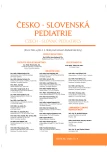Prenatal phenotype of RASopathies
Authors:
J. Pavlíček 1,2
Authors‘ workplace:
Klinika dětského lékařství, Fakultní nemocnice Ostrava, Lékařská fakulta Ostravské univerzity, Ostrava
1; Centrum biomedicínského výzkumu FN Hradec Králové
2
Published in:
Čes-slov Pediat 2020; 75 (4): 232-238.
Category:
Overview
RASopathy is a group of syndromes that are caused by germline mutations in genes that encode components of the RAS/MAPK signaling pathway. This pathway is key for cell regulation, proliferation, differentiation, and survival. For the great heterogeneity of phenotypic manifestations, the clinical diagnosis prevailed in the past years after birth, but the detection of these syndromes is possible also prenatally. Ultrasound examination of the fetus during screening tests plays a major role. Typical common features and indication criteria for RASopathy sequencing include pathological nuchal translucency measurement, lymphatic jugular sacs enlargement, development of cystic hygroma, effusions or fetal hydrops, polyhydramnios, congenital heart disease, and renal pathology. In pathological prenatal screening, even with normal karyotype results, additional ultrasound and genetic fetal examination are appropriate.
Keywords:
Noonan syndrome – nuchal translucence – prenatal screening – RASopathy
Sources
1. Aoki Y, Niihori T, Inoue S, Matsubara Y. Recent advances in RASopathies. J Hum Genet 2016; 61: 33–39.
2. Klásková E, Tüdös Z, Sobek A, et al. Low-level 45, X/46, XX mosaicism is not associated with congenital heart disease and thoracic aorta dilatation: prospective magnetic resonance imaging and ultrasound study. Ultrasound Obstet Gynecol 2015; 45 (6): 722–727.
3. Wright EMB, Kerr B. RAS-MAPK pathway disorders: important causes of congenital heart disease, feeding difficulties, developmental delay and short stature. Arch Dis Child 2010; 95 (9): 724–730.
4. Baldassarre G, Mussa A, Dotta A, et al. Prenatal features of Noonan syndrome: prevalence and prognostic value. Prenat Diagn 2011; 31 (10): 949–954.
5. Moczulska H, Piotrowicz M, Janiak K, et al. Prenatal suspicion of Noonan syndrome on the basis of echocardiographic findings – a case report. Prenat Cardio 2013; 3 (2): 26–30.
6. Sznajer Y, Keren B, Baumann C, et al. The spectrum of cardiac anomalies in Noonan syndrome as a result of mutations in the PTPN11 gene. Pediatrics 2007; 119: 1325–1331.
7. International Society of Ultrasound in Obstetrics & Gynecology. Cardiac screening examination of the fetus: guidelines for performing the ‚basic‘ and ‚extended basic‘ cardiac scan. Ultrasound Obstet Gynecol 2006; 27 (1):107.
8. Menashe M, Arbel R, Raveh D, et al. Poor prenatal detection rate of cardiac anomalies in Noonan syndrome. Ultrasound Obstet Gynecol 2002; 19: 51–55.
9. Achiron R, Heggesh J, Grisaru D, et al. Noonan syndrome: a cryptic condition in early gestation. Am J Med Genet 2000; 92 (3): 159–165.
10. Abe Y, Aoki Y, Kuriyama S, et al. Prevalence and clinical features of Costello syndrome and cardio-facio-cutaneous syndrome in Japan: Findings from a nationwide epidemiological survey. Am J Med Genet A 2012; 158 (5): 1083–1094.
11. Wong Ramsey KN, Loichinger MH, Slavin TP, et al. The perinatal presentation of cardiofaciocutaneous syndrome. Am J Med Genet A 2014; 164 (8): 2036–2042.
12. Philip N, Quarello E, Gorincour G, Sigaudy S. Approche de la dysmorphologie fœtale in utero. Gynecol Obstet Fertil 2010; 38 (11): 677–685.
13. Pierpont MEM, Magoulas PL, Adi S, et al. Cardio-facio-cutaneous syndrome: clinical features, diagnosis, and management guidelines. Pediatrics 2014; 134 (4): e1149–e1162.
14. Biard JM, Steenhaut P, Bernard, P, et al. Antenatal diagnosis of cardio-facio-cutaneous syndrome: Prenatal characteristics and contribution of fetal facial dysmorphic signs in utero. About a case and review of literature. Eur J Obstet Gynecol R B 2019; 240: 232–241.
15. Smith LP, Podraza J, Proud VK. Polyhydramnios, fetal overgrowth, and macrocephaly: prenatal ultrasound findings of Costello syndrome. Am J Med Genet A 2009; 149 (4): 779–784.
16. Kuniba H, Pooh RK, Sasaki K, et al. Prenatal diagnosis of Costello syndrome using 3D ultrasonography amniocentesis confirmation of the rare HRAS mutation G12D. Am J Med Genet A 2009; 149 (4): 785–787.
17. Hague J, Hackett G, Acerini C, Park SM. Prenatal genetic diagnosis of Costello syndrome in a male fetus with recurrent HRAS mutation p. Gly12Ser. Prenat Diagn 2017; 37 (4): 409–411.
18. Ali MM, Chasen ST, Norton ME. Testing for Noonan syndrome after increased nuchal translucency. Prenat Diagn 2017; 37: 750–753.
19. Croonen EA, Nillesen WM, Stuurman KE, et al. Prenatal diagnostic testing of the Noonan syndrome genes in fetuses with abnormal ultrasound findings. Eur J Hum Genet 2013; 21 (9): 936–942.
20. Levaillant JM, Gérard-Blanluet M, Holder-Espinasse M, et al. Prenatal phenotypic overlap of Costello syndrome and severe Noonan syndrome by tri-dimensional ultrasonography. Prenat Diagn 2006; 26 (4): 340–344.
21. Weis D, et al. Neurofibromatóza a iné syndromy s „café au lait“ makulami. Praha: Mladá fronta, 2020.
Labels
Neonatology Paediatrics General practitioner for children and adolescentsArticle was published in
Czech-Slovak Pediatrics

2020 Issue 4
Most read in this issue
- Noonan syndrome and other RASopathies: Aetiology, diagnostic procedures and therapy
- Noonan syndrome from a paediatric cardiologistˇs perspective
- Etiology and diagnostic approach of growth failure in children born small for gestational age (SGA) with persistent short stature in childhood (SGA-SS)
- Prenatal phenotype of RASopathies
